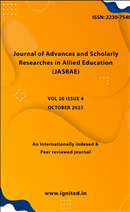Impact of Solar Variability on Cosmic Rays and Geomagnetic field During Solar Cycle 23 And 24
Keywords:
cosmic rays, solar variability, geomagnetic field, solar cycle, spaceborne particles, observed findings, periodic modulation, sporadic modulation, Forbush decline, transitory dropAbstract
Cosmic rays are very energetic spaceborne particles that collide with Earth's atmosphere. Thisresearch examines the observed findings and the effects of solar variability on cosmic rays and thegeomagnetic field from 1996 to 2015. Two types of cosmic ray modulation have been identified periodicand sporadic. Sporadic categories include Forbush decline, transitory drop, and ground levelenhancement (GLE). Galactic cosmic ray variation is also known as long-term variation, while Forbushreduction is short-term variation. Long-term variations in cosmic ray intensity exhibit an 11-year cyclewith one peak every cycle. Solar activity and cosmic ray intensity are inversely correlated.References
Shalaby, S. & Darwish, A. & Ayman, Aly & Hanfi, M. & Ambrosino, Fabrizio & Alqahtani, Mohammed & Elshoukrofy, Abeer. (2023). Analysis of a significant Forbush depression of solar cycles 24 and 25 (2008–2021). The European Physical Journal Plus. 138. 10.1140/epjp/s13360-023-04426-y.
Мелкумян, Анаид & Melkumyan, Anaid & Белов, Анатолий & Belov, Anatoliy & Абунина, Мария & Abunina, Maria & Абунин, Артем & Abunin, Artem & Ерошенко, Евгения & Eroshenko, Evgeniya & Оленева, Виктория & Oleneva, Viktoria & Янке, Виктор & Yanke, Viktor. (2019). Recurrent and sporadic Forbush decreases during solar cycles 23–24. Solar-Terrestrial Physics. 5. 28-34. 10.12737/stp-51201904.
Papailiou, M. & Abunina, Maria & Belov, A. & Eroshenko, E. & Yanke, Victor & Mavromichalaki, H. (2020). Large Forbush Decreases and their Solar Sources: Features and Characteristics. Solar Physics. 295. 10.1007/s11207-020-01735-8.
Kharayat, Hema & Prasad, Lalan & Mathpal, Rajesh & Garia, Suman & Bhatt, Beena. (2016). Study of Cosmic Ray Intensity in Relation to the Interplanetary Magnetic Field and Geomagnetic Storms for Solar Cycle 23. Solar Physics. 291. 603-611. 10.1007/s11207-016-0852-y.
Mathpal, & Prasad, Lalan & Pokharia, Meena & Bhoj, Chandrashekhar. (2018). Study of cosmic ray intensity in relation to the interplanetary magnetic field and geomagnetic storms for solar cycle 24. Astrophysics and Space Science. 363. 10.1007/s10509-018-3390-2.
Melkumyan A A, Belov A V, Abunina M A, Abunin A A, Eroshenko E A, Oleneva V A and Yanke V G 2018 Geomagn. Aeron. 58 154–168
Belov A, Eroshenko E, Yanke V, Oleneva V, Abunin A, Abunina M, Papaioannou A and Mavromichalaki H 2018 Sol. Phys. 293 68
Yang, S., Zhang, J., Zhu, X., & Song, Q. (2017). Block‐induced complex structures building the flare‐productive solar active region 12673. Astrophysical Journal Letters, 849(2), L21. https://doi.org/10.3847/2041‐8213/aa9476
Yermolaev, Y. I., Lodkina, I. G., Nikolaeva, M. Y., & Yermolaev, M. Y. (2014). Influence of the interplanetary driver type on the durations of the main and recovery phases of magnetic storms. Journal of Geophysical Research: Space Physics, 119, 8126–8136. https://doi.org/ 10.1002/2014JA019826
Webb, D. F., & Howard, T. A. (2012). Coronal mass ejections: Observations. Living Reviews of Solar Physics, 9(3). https://doi.org/10.12942/lrsp‐2012‐3
Yan, X. L., Wang, J. C., Pan, G. M., Kong, D. F., Xue, Z. K., Yang, L. H., et al. (2018). Successive X‐class flares and coronal mass ejections driven by shearing motion and sunspot rotation in active region NOAA 12673. Astrophysical Journal, 856(1), 79. https://doi.org/10.3847/ 1538‐4357/aab153
Raghav, A., Bhaskar, A., Lotekar, A., Vichare, G., & Yadav, V. (2014). Quantitative understanding of Forbush decrease drivers based on shock‐only and CME‐only models using global signature of February 14, 1978 event. Journal of Cosmology and Astroparticle Physics, 2014(10), 074. https://doi.org/10.1088/1475‐7516/2014/10/074
Raghav, A., Shaikh, Z., Bhaskar, A., Datar, G., & Vichare, G. (2017). Forbush decrease: A new perspective with classification. Solar Physics, 292(8), 99.
Lingri, D., Mavromichalaki, H., Belov, A., Eroshenko, E., Yanke, V., Abunin, A., & Abunina, M. (2016). Solar activity parameters and associated Forbush decreases during the minimum between cycles 23 and 24 and the ascending phase of cycle 24. Solar Physics, 291(3), 1025–1041.
Luhmann, J. G., Mays, M. L., Li, Y., Lee, C. O., Bain, H., Odstrcil, D., et al. (2018). Shock connectivity and the late cycle 24 solar energetic particle events in July and September 2017. Space Weather, 16, 557–568. https://doi.org/10.1029/2018SW001860








